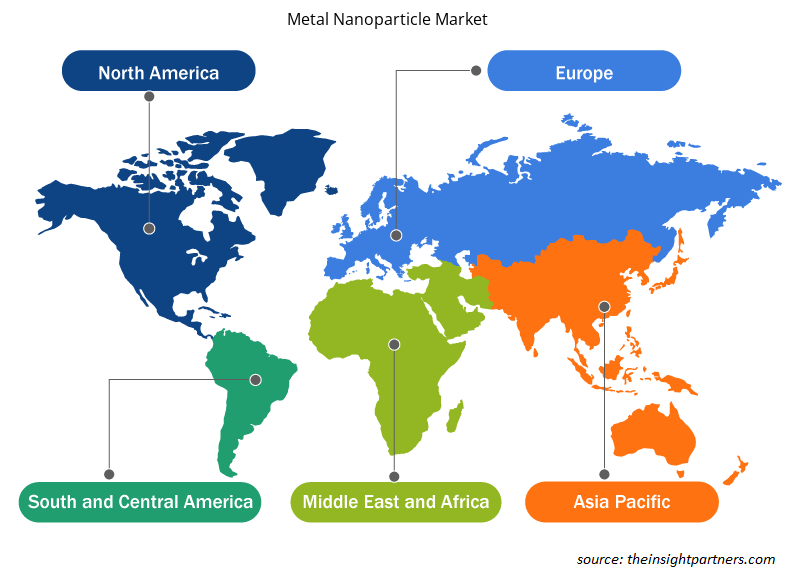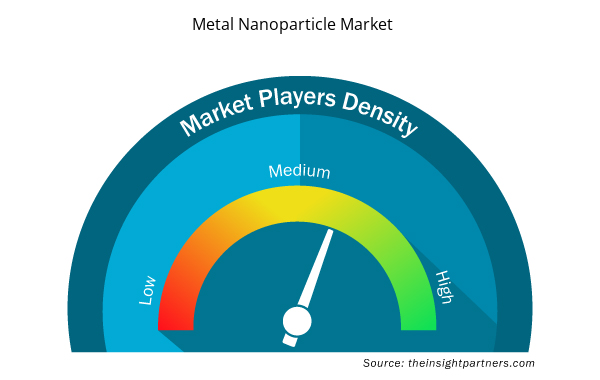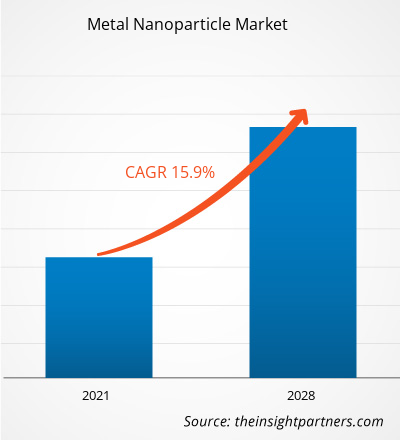[Forschungsbericht] Der Markt für Metallnanopartikel wurde im Jahr 2020 auf 25.373,92 Millionen US-Dollar geschätzt und soll bis 2028 81.567,38 Millionen US-Dollar erreichen; von 2021 bis 2028 wird ein durchschnittliches jährliches Wachstum von 15,9 % erwartet.
Metallnanopartikel haben außergewöhnliche Eigenschaften wie ein hohes Aspektverhältnis und eine einheitliche Größe. Sie werden in einem breiten Anwendungsspektrum eingesetzt, beispielsweise in der Katalyse, in der Medizin und bei der Energiespeicherung. Die Metallnanopartikel haben verschiedene Anwendungen in Endverbrauchsbranchen, beispielsweise in der Pharma- und Gesundheitsbranche, in der Chemie, der Kosmetik sowie in der Elektro- und Elektronikbranche.
Im Jahr 2020 hatte Nordamerika den größten Marktanteil. Die zunehmende Entwicklung des Pharma- und Gesundheitssektors und die steigende Nachfrage nach nachhaltigen Energieressourcen haben die Nachfrage nach Metallnanopartikeln in Nordamerika erhöht. Dank der Präsenz von Industrieländern wie den USA und Kanada und der förderlichen staatlichen Unterstützung von F&E-Aktivitäten erforschen und produzieren die Länder der Region innovative Produkte. Darüber hinaus haben die Fortschritte in der Medizintechnik und die erhöhten Investitionen in den Gesundheitssektor die Nachfrage nach Metallnanopartikeln in der Medizinbranche angekurbelt. Darüber hinaus hat die Präsenz inländischer und internationaler Metallnanopartikelunternehmen in der Region lukrative Möglichkeiten für den Metallnanopartikelmarkt in der Region geschaffen.
Die anhaltende COVID-19-Pandemie hat erhebliche Auswirkungen auf den Markt für Metallnanopartikel. Der Ausbruch hat die Betriebseffizienz beeinträchtigt und die Wertschöpfungsketten aufgrund der plötzlichen Schließung nationaler und internationaler Grenzen unterbrochen, was zu Umsatzverlusten und Schäden geführt hat. Die Störungen in der Produktion und Lieferkette haben sich negativ auf den Markt für Metallnanopartikel ausgewirkt. Die Einführung von Ausgangssperren in verschiedenen Ländern zusammen mit Reisebeschränkungen hat die weltweite Produktversorgung verringert und den Logistikbetrieb reduziert. Es wird an der Verwendung von Goldnanopartikeln für COVID-19-Testkits geforscht, die die Ergebnisse innerhalb von Minuten liefern sollen. In den USA behauptete eine Gruppe von Forschern an der University of Maryland, sie hätten einen Diagnosetest entwickelt, der das neuartige Coronavirus, das COVID-19 verursacht, innerhalb von 10 Minuten nachweisen kann und dessen Ergebnisse mit bloßem Auge sichtbar sind. Der Test ist ein einfacher kolorimetrischer Test, der Goldnanopartikel verwendet, die mit der Nukleinsäuresequenz des Nukleokapsidphosphoproteins des SARS-COV-2-Virus beschichtet sind. Darüber hinaus hat Sugentech, Inc. (ein Unternehmen in der Republik Korea) das SGTi-flex COVID-19 IgM/IgG-Testkit entwickelt, ein immunchromatographisches Testkit auf Basis von Goldnanopartikeln, das die IgM- und IgG-Antikörper von COVID-19 bestimmt. Der Test hilft bei der Bestimmung der Antikörper, bei denen es sich um spezifische Proteine handelt, die als Reaktion auf die Infektion entwickelt werden. Daher wirkt sich eine zunehmende Verwendung von Goldnanopartikeln im Gesundheitssektor positiv auf den Markt für Metallnanopartikel aus.
Passen Sie diesen Bericht Ihren Anforderungen an
Sie erhalten kostenlos individuelle Anpassungen an jedem Bericht, einschließlich Teilen dieses Berichts oder einer Analyse auf Länderebene, eines Excel-Datenpakets sowie tolle Angebote und Rabatte für Start-ups und Universitäten.
- Holen Sie sich die wichtigsten Markttrends aus diesem Bericht.Dieses KOSTENLOSE Beispiel umfasst eine Datenanalyse von Markttrends bis hin zu Schätzungen und Prognosen.
Markteinblicke
Anwendung von Metallnanopartikeln in der Medizinindustrie
In der Medizinbranche werden Metallnanopartikel zunehmend in Therapeutika, Arzneimittelverabreichung, Biobildgebung und Krebsdiagnostik sowie -behandlung eingesetzt, um nur einige Beispiele zu nennen. Verschiedene Arten von Metallnanopartikeln, darunter Silber, Titan, Gold, Platin und Kupfer, sind für ihre potenziellen therapeutischen Wirkungen bekannt. Gold- und Silbernanopartikel hemmen wirksam das Wachstum von gramnegativen und grampositiven Bakterien. Goldnanopartikel werden verwendet, um Biomarker bei der Diagnose von Infektionskrankheiten, Krebs und Herzkrankheiten zu erkennen. Platinnanopartikel werden aufgrund ihrer inhärenten antimikrobiellen, antioxidativen und krebshemmenden Eigenschaften in biomedizinischen Anwendungen wie Implantaten, Bildgebung, photothermischer Therapie und Arzneimittelverabreichung eingesetzt. Titannanopartikel werden verwendet, um Bakterien auf verschiedenen Oberflächen abzutöten. Wenn sie ultravioletter Strahlung ausgesetzt werden, erzeugen diese Nanopartikel eine starke oxidative Wirkung und wirken als photokatalytische Desinfektionsmittel. Silbernanopartikel haben antimikrobielle und krebshemmende Eigenschaften und werden zunehmend bei der Herstellung von Wundbeschichtungen und Gerätebeschichtungen verwendet. Kupfernanopartikel werden im medizinischen Bereich zum Schutz, zur Kontrolle und zur Behandlung von Infektionen eingesetzt. Daher treibt ein Anstieg der Anwendung verschiedener Metallnanopartikel in der medizinischen Industrie den Markt für Metallnanopartikel an.
Metalleinblicke
Basierend auf Metall ist der Markt für Metallnanopartikel in Platin, Gold, Silber, Eisen, Titan und andere unterteilt. Im Jahr 2020 dominierte das Segment „Sonstige“ den Markt. Die anderen Metallnanopartikel bestehen aus Metallen wie Zink, Kupfer, Silizium, Mangan, Aluminium, Nickel, Cer und Thallium. Zinknanopartikel sind anorganische Metalloxide und können sicher in Medikamenten, als Konservierungsmittel in Verpackungen und als antimikrobielles Mittel verwendet werden. Zinknanopartikel diffundieren leicht in das Lebensmittelmaterial und töten die Mikroben ab. Kupfernanopartikel werden durch den natürlichen Prozess oder durch chemische Synthese hergestellt. Sie werden zunehmend als Farbstoff und antimikrobielles Mittel verwendet. Siliziumnanopartikel werden hauptsächlich in elektrischen und thermischen Isolatoren und in Anwendungen zur Arzneimittelverabreichung verwendet. Mangan-Nanopartikel (Nanopunkte oder Nanopulver) sind kugelförmige oder facettenreiche nanostrukturierte Metallpartikel mit großer Oberfläche. Aluminium-Nanopartikel haben eine größere Wasserstoffspeicherkapazität und werden häufig in Flugzeugen, Militäranwendungen, Automobilen und Raketentreibstoffen eingesetzt.
Zu den wichtigsten Marktteilnehmern auf dem Markt für Metallnanopartikel zählen American Elements, BBI Group, EPRUI Biotech Co. Ltd., Meliorum Technologies, Inc., Nanocomposix, Nanosc, Inc., Nanostructured and Amorphous Materials, Inc., Nanoshel LLC., TANAKA HOLDINGS Co., Ltd. und US Research Nanomaterials INC. Wichtige Marktteilnehmer verfolgen Strategien wie Fusionen und Übernahmen sowie Produkteinführungen, um ihre geografische Präsenz und Kundenbasis zu erweitern.
Bericht-Spotlights
- Progressive Trends in der Metallnanopartikelindustrie helfen den Akteuren bei der Entwicklung wirksamer langfristiger Strategien
- Von Unternehmen verfolgte Geschäftswachstumsstrategien zur Sicherung des Wachstums in entwickelten und sich entwickelnden Märkten
- Quantitative Analyse des globalen Marktes für Metallnanopartikel von 2019 bis 2028
- Schätzung der Nachfrage nach Metallnanopartikeln in verschiedenen Branchen
- Porter-Analyse zur Veranschaulichung der Wirksamkeit von in der Branche tätigen Käufern und Lieferanten bei der Vorhersage des Marktwachstums
- Aktuelle Entwicklungen zum Verständnis des Wettbewerbsmarktszenarios und der Nachfrage nach Metallnanopartikeln
- Markttrends und -aussichten in Verbindung mit Faktoren, die das Wachstum des Marktes für Metallnanopartikel vorantreiben und bremsen
- Verständnis der Strategien, die das kommerzielle Interesse im Hinblick auf das Wachstum des globalen Marktes für Metallnanopartikel untermauern, als Unterstützung des Entscheidungsprozesses
- Marktgröße für Metallnanopartikel an verschiedenen Marktknoten
- Detaillierte Übersicht und Segmentierung des globalen Marktes für Metallnanopartikel sowie seiner Branchendynamik
- Marktgröße für Metallnanopartikel in verschiedenen Regionen mit vielversprechenden Wachstumschancen
Metallnanopartikel
Regionale Einblicke in den Markt für Metallnanopartikel
Die regionalen Trends und Faktoren, die den Markt für Metallnanopartikel im Prognosezeitraum beeinflussen, wurden von den Analysten von Insight Partners ausführlich erläutert. In diesem Abschnitt werden auch die Marktsegmente und die Geografie für Metallnanopartikel in Nordamerika, Europa, im asiatisch-pazifischen Raum, im Nahen Osten und Afrika sowie in Süd- und Mittelamerika erörtert.

- Holen Sie sich die regionalspezifischen Daten für den Markt für Metallnanopartikel
Umfang des Marktberichts über Metallnanopartikel
| Berichtsattribut | Details |
|---|---|
| Marktgröße im Jahr 2020 | 25,37 Milliarden US-Dollar |
| Marktgröße bis 2028 | 81,57 Milliarden US-Dollar |
| Globale CAGR (2020 - 2028) | 15,9 % |
| Historische Daten | 2018-2019 |
| Prognosezeitraum | 2021-2028 |
| Abgedeckte Segmente | Von Metal
|
| Abgedeckte Regionen und Länder | Nordamerika
|
| Marktführer und wichtige Unternehmensprofile |
|
Marktteilnehmerdichte für Metallnanopartikel: Auswirkungen auf die Geschäftsdynamik verstehen
Der Markt für Metallnanopartikel wächst rasant, angetrieben durch die steigende Nachfrage der Endverbraucher aufgrund von Faktoren wie sich entwickelnden Verbraucherpräferenzen, technologischen Fortschritten und einem größeren Bewusstsein für die Vorteile des Produkts. Mit steigender Nachfrage erweitern Unternehmen ihr Angebot, entwickeln Innovationen, um die Bedürfnisse der Verbraucher zu erfüllen, und nutzen neue Trends, was das Marktwachstum weiter ankurbelt.
Die Marktteilnehmerdichte bezieht sich auf die Verteilung der Firmen oder Unternehmen, die in einem bestimmten Markt oder einer bestimmten Branche tätig sind. Sie gibt an, wie viele Wettbewerber (Marktteilnehmer) in einem bestimmten Marktraum im Verhältnis zu seiner Größe oder seinem gesamten Marktwert präsent sind.
Die wichtigsten auf dem Markt für Metallnanopartikel tätigen Unternehmen sind:
- Amerikanische Elemente
- BBI-Gruppe
- EPRUI Biotech Co. Ltd.
- Meliorum Technologies, Inc.
- Nanokomposit
Haftungsausschluss : Die oben aufgeführten Unternehmen sind nicht in einer bestimmten Reihenfolge aufgeführt.

- Überblick über die wichtigsten Akteure auf dem Markt für Metallnanopartikel
Markt für Metallnanopartikel, nach Metall
- Platin
- Gold
- Silber
- Eisen
- Titan
- Sonstiges
Markt für Metallnanopartikel nach Anwendung
- Pharmazeutik und Gesundheitswesen
- Elektrik und Elektronik
- Chemikalien
- Körperpflege und Kosmetik
- Sonstiges
Firmenprofile
- Amerikanische Elemente
- BBI-Gruppe
- EPRUI Biotech Co. Ltd.
- Meliorum Technologies, Inc.
- Nanokomposit
- Nanosc, Inc.
- Nanostrukturierte und amorphe Materialien, Inc.
- Nanoshel LLC
- TANAKA HOLDINGS Co., Ltd.
- US Research Nanomaterials INC
- Historische Analyse (2 Jahre), Basisjahr, Prognose (7 Jahre) mit CAGR
- PEST- und SWOT-Analyse
- Marktgröße Wert/Volumen – Global, Regional, Land
- Branche und Wettbewerbsumfeld
- Excel-Datensatz



Report Coverage
Revenue forecast, Company Analysis, Industry landscape, Growth factors, and Trends

Segment Covered
This text is related
to segments covered.

Regional Scope
North America, Europe, Asia Pacific, Middle East & Africa, South & Central America

Country Scope
This text is related
to country scope.
Häufig gestellte Fragen
In 2020, the others segment dominated the market. The other metal nanoparticles are made of metals such as zinc, copper, silica, manganese, aluminum, nickel, cerium, and thallium. Zinc nanoparticle is an inorganic metal oxide and can be safely used in medicines, as a preservative in packaging and an antimicrobial agent. Zinc nanoparticles easily diffuse into the food material as well as kills the microbe.
In 2020, the electricals and electronics segment dominated the market. Gold nanoparticles are being used as a conductor in applications ranging from printable inks to electronic chips. They are increasingly used to connect conductors, resistors, and various other elements of an electronic chip.
In 2020, pharmaceutical and healthcare dominated the metal nanoparticle market. In the medical industry, metal nanoparticles are increasingly being used in therapeutic agents, drug delivery, bioimaging, and cancer diagnostics as well as treatment, among other applications. Various types of metal nanoparticles, including silver, titanium, gold, platinum, and copper, are known for their potential therapeutic effects.
In 2020, Asia Pacific, emerged as the fastest growing regional market. The growing healthcare industry in Asia Pacific is leading to an increased demand for metal nanoparticles. The gold nanoparticles are used in the pharmaceutical sector to produce different medicated drugs, along with various engineered technologies that use nanoparticles for the targeted delivery and release of therapeutic agents.
The major players operating in the global metal nanoparticle market are American Elements; BBI Group; EPRUI Biotech Co. Ltd.; Meliorum Technologies, Inc.; Nanocomposix; Nanosc, Inc.; Nanostructured and Amorphous Materials, Inc.; Nanoshel LLC.; TANAKA HOLDINGS Co., Ltd.; and US Research Nanomaterials INC among many others.
In 2020, North America accounted for the largest share in the market. The increase in the development of the pharmaceutical and the healthcare sectors and a rise in demand for sustainable energy resources have increased the demand for metal nanoparticles in North America. Owing to the presence of developed countries, such as the US and Canada, and conducive government support for R&D activities, countries in the region explore and produce innovative products.
Trends and growth analysis reports related to Chemicals and Materials : READ MORE..
The List of Companies - Metal Nanoparticles Market
- American Elements
- BBI Group
- EPRUI Biotech Co. Ltd.
- Meliorum Technologies, Inc.
- Nanocomposix
- Nanosc, Inc.
- Nanostructured and Amorphous Materials, Inc.
- Nanoshel LLC.
- TANAKA HOLDINGS Co., Ltd.
- US Research Nanomaterials INC
The Insight Partners performs research in 4 major stages: Data Collection & Secondary Research, Primary Research, Data Analysis and Data Triangulation & Final Review.
- Data Collection and Secondary Research:
As a market research and consulting firm operating from a decade, we have published and advised several client across the globe. First step for any study will start with an assessment of currently available data and insights from existing reports. Further, historical and current market information is collected from Investor Presentations, Annual Reports, SEC Filings, etc., and other information related to company’s performance and market positioning are gathered from Paid Databases (Factiva, Hoovers, and Reuters) and various other publications available in public domain.
Several associations trade associates, technical forums, institutes, societies and organization are accessed to gain technical as well as market related insights through their publications such as research papers, blogs and press releases related to the studies are referred to get cues about the market. Further, white papers, journals, magazines, and other news articles published in last 3 years are scrutinized and analyzed to understand the current market trends.
- Primary Research:
The primarily interview analysis comprise of data obtained from industry participants interview and answers to survey questions gathered by in-house primary team.
For primary research, interviews are conducted with industry experts/CEOs/Marketing Managers/VPs/Subject Matter Experts from both demand and supply side to get a 360-degree view of the market. The primary team conducts several interviews based on the complexity of the markets to understand the various market trends and dynamics which makes research more credible and precise.
A typical research interview fulfils the following functions:
- Provides first-hand information on the market size, market trends, growth trends, competitive landscape, and outlook
- Validates and strengthens in-house secondary research findings
- Develops the analysis team’s expertise and market understanding
Primary research involves email interactions and telephone interviews for each market, category, segment, and sub-segment across geographies. The participants who typically take part in such a process include, but are not limited to:
- Industry participants: VPs, business development managers, market intelligence managers and national sales managers
- Outside experts: Valuation experts, research analysts and key opinion leaders specializing in the electronics and semiconductor industry.
Below is the breakup of our primary respondents by company, designation, and region:

Once we receive the confirmation from primary research sources or primary respondents, we finalize the base year market estimation and forecast the data as per the macroeconomic and microeconomic factors assessed during data collection.
- Data Analysis:
Once data is validated through both secondary as well as primary respondents, we finalize the market estimations by hypothesis formulation and factor analysis at regional and country level.
- Macro-Economic Factor Analysis:
We analyse macroeconomic indicators such the gross domestic product (GDP), increase in the demand for goods and services across industries, technological advancement, regional economic growth, governmental policies, the influence of COVID-19, PEST analysis, and other aspects. This analysis aids in setting benchmarks for various nations/regions and approximating market splits. Additionally, the general trend of the aforementioned components aid in determining the market's development possibilities.
- Country Level Data:
Various factors that are especially aligned to the country are taken into account to determine the market size for a certain area and country, including the presence of vendors, such as headquarters and offices, the country's GDP, demand patterns, and industry growth. To comprehend the market dynamics for the nation, a number of growth variables, inhibitors, application areas, and current market trends are researched. The aforementioned elements aid in determining the country's overall market's growth potential.
- Company Profile:
The “Table of Contents” is formulated by listing and analyzing more than 25 - 30 companies operating in the market ecosystem across geographies. However, we profile only 10 companies as a standard practice in our syndicate reports. These 10 companies comprise leading, emerging, and regional players. Nonetheless, our analysis is not restricted to the 10 listed companies, we also analyze other companies present in the market to develop a holistic view and understand the prevailing trends. The “Company Profiles” section in the report covers key facts, business description, products & services, financial information, SWOT analysis, and key developments. The financial information presented is extracted from the annual reports and official documents of the publicly listed companies. Upon collecting the information for the sections of respective companies, we verify them via various primary sources and then compile the data in respective company profiles. The company level information helps us in deriving the base number as well as in forecasting the market size.
- Developing Base Number:
Aggregation of sales statistics (2020-2022) and macro-economic factor, and other secondary and primary research insights are utilized to arrive at base number and related market shares for 2022. The data gaps are identified in this step and relevant market data is analyzed, collected from paid primary interviews or databases. On finalizing the base year market size, forecasts are developed on the basis of macro-economic, industry and market growth factors and company level analysis.
- Data Triangulation and Final Review:
The market findings and base year market size calculations are validated from supply as well as demand side. Demand side validations are based on macro-economic factor analysis and benchmarks for respective regions and countries. In case of supply side validations, revenues of major companies are estimated (in case not available) based on industry benchmark, approximate number of employees, product portfolio, and primary interviews revenues are gathered. Further revenue from target product/service segment is assessed to avoid overshooting of market statistics. In case of heavy deviations between supply and demand side values, all thes steps are repeated to achieve synchronization.
We follow an iterative model, wherein we share our research findings with Subject Matter Experts (SME’s) and Key Opinion Leaders (KOLs) until consensus view of the market is not formulated – this model negates any drastic deviation in the opinions of experts. Only validated and universally acceptable research findings are quoted in our reports.
We have important check points that we use to validate our research findings – which we call – data triangulation, where we validate the information, we generate from secondary sources with primary interviews and then we re-validate with our internal data bases and Subject matter experts. This comprehensive model enables us to deliver high quality, reliable data in shortest possible time.


 Holen Sie sich ein kostenloses Muster für diesen Bericht
Holen Sie sich ein kostenloses Muster für diesen Bericht